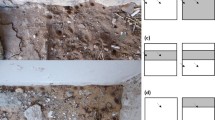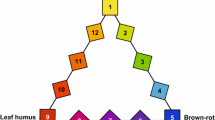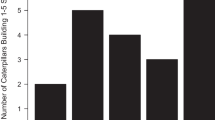Abstract
Many caterpillars construct shelters by folding leaves and feeding from within. Many shelter-constructing species suffer high rates of parasitism as larvae or pupae. In spite of the likely significance, the effects of these shelters on the survival of pupae and the trade-off between feeding and constructing shelters have attracted little experimental attention. In both field and laboratory experiments, fern-feeding caterpillars [Herpetogramma theseusalis (Walker) (Lepidoptera: Crambidae)] invested heavily in shelters, losing weight and significantly delaying pupation rather than feeding or pupating in exposed locations. Experimentally thinning the walls of shelters in the field doubled the parasitism rate. Parasitism of pupae exceeded predation by an order of magnitude or more in both seasons of this study. Caterpillars constructed similarly sized shelters regardless of availability of fern fronds, resulting in incomplete shelters on especially small fronds, putting pupae at increased risk of parasitism. We suggest that similar interactions are common and merit more attention.




Similar content being viewed by others
References
Abarca M, Boege K (2011) Fitness costs and benefits of shelter building and leaf trenching behaviour in a pyralid caterpillar. Ecol Entomol 36:564–573
Brault S (1991) Host choice and offspring sex allocation in a solitary parasitic wasp. Behav Ecol Sociobiol 29:353–360
Cerda O, Hinojosa IA, Thiel M (2010) Shelter-building behavior by the amphipod Peramphithoe femorata (Kroyer) on the kelp Macrocystis pyrifera (Linnaeus) C. Agardh from northern-central Chile. Biol Bull 218:248–258
Danks HV (2002) Modification of adverse conditions by insects. Oikos 99:10–24
De Moraes CM, Lewis WJ, Paré PW, Alborn HT, Tumlinson JH (1998) Herbivore-infested plants selectively attract parasitoids. Nature 393:570–573
Diniz IR, Hay JD, Rico-Gray V, Greeney HF, Morais HC (2012) Shelter-building caterpillars in the cerrado: seasonal variation in relative abundance, parasitism, and the influence of extra-floral nectaries. Arthropod Plant Interact 6:583–589
Fukui A (2001) Indirect interactions mediated by leaf-shelters in animal-plant communities. Popul Ecol 43:31–40
Gentry GL, Dyer LA (2002) On the conditional nature of neotropical caterpillar defenses against their natural enemies. Ecology 83:3108–3119
Godfray HCJ (1994) Parasitoids. Princeton University Press, New Jersey
Greeney HF, Walla TR, Lynch RL (2010) Architectural changes in larval leaf shelters of Noctuana haematospila (Lepidoptera: Hesperiidae) between host plant species with different leaf thicknesses. Zoologia 27:65–69
Greeney HF, Dyer LA, Smilanich AM (2012) Feeding by lepidopteran larvae is dangerous: a review of caterpillars’ chemical, physiological, morphological, and behavioral defenses against natural enemies. Invert Surv J 9:7–34
Hagen SB, Sorlibraten O, Ims RA, Yoccoz NG (2006) Density-dependent melanism in winter moth larvae (Lepidoptera: Geometridae): a countermeasure against parasitoids? Environ Entomol 35:1249–1253
Hawkins BA (1994) Pattern and process in host–parasitoid interactions. Cambridge University Press, Cambridge
Hawkins BA, Cornell HV, Hochberg ME (1997) Predators, parasitoids, and pathogens as mortality agents in phytophagous insect populations. Ecology 78:2145–2152
Hochberg ME, Hawkins BA (1992) Refuges as a predictor of parasitoid diversity. Science 255:973–976
Jervis MA, Kidd NAC (1986) Host-feeding strategies in hymenopterous parasitoids. Biol Rev 61:395–434
Jones MT, Castellanos I, Weiss MR (2002) Do leaf-shelters always protect caterpillars from invertebrate predators? Ecol Entomol 27:753–757
Lill JT, Marquis RJ (2003) Ecosystem engineering by caterpillars increases insect herbivore diversity on white oak. Ecology 84:682–690
Lill JT, Marquis RJ (2007) Microhabitat manipulation: ecosystem engineering by shelter-building insects. In: Cuddington K, Byers JE, Wilson WG, Hastings A (eds) Ecosystem engineers. Academic Press, London, pp 107–138
Lill JT, Marquis RJ, Walker MA, Peterson L (2007) Ecological consequences of shelter sharing by leaf-tying caterpillars. Entomol Exp Appl 124:45–53
Loeffler CC (1994) Natural history of leaf-folding caterpillars, Dichomeris spp. (Gelechiidae), on goldenrods and asters. J N Y Entomol Soc 102:405–428
Loeffler CC (1996a) Caterpillar leaf folding as a defense against predation and dislodgement: staged encounters using Dichomeris (Gelechiidae) larvae on goldenrods. J Lepid Soc 50:245–260
Loeffler CC (1996b) Adaptive trade-offs of leaf folding in Dichomeris caterpillars on goldenrods. Ecol Entomol 21:34–40
Martinsen GD, Floate KD, Waltz AM, Wimp GM, Whitham TG (2000) Positive interactions between leafrollers and other arthropods enhance biodiversity on hybrid cottonwoods. Oecologia 123:82–89
Morse DH (2009) Four-level interactions: herbivore use of ferns and subsequent parasitoid-hyperparasitoid performance. Ecol Entomol 34:246–253
Morse DH (2011) Size and development times of herbivorous host and parasitoid on distantly related foodplants. Am Midl Nat 166:252–265
Nakamura M, Ohgushi T (2003) Positive and negative effects of leaf shelters on herbivorous insects: linking multiple herbivore species on a willow. Oecologia 136:445–449
Ruehlmann TE, Matthews RW, Matthews JR (1988) Roles for structural and temporal shelter-changing by fern-feeding lepidopteran larvae. Oecologia 75:228–232
Sagers CL (1992) Manipulation of host plant quality: herbivores keep leaves in the dark. Funct Ecol 6:741–743
Schott T, Hagen SB, Ims RA, Yoccoz NG (2010) Are population outbreaks in sub-arctic geometrids terminated by larval parasitoids? J Anim Ecol 79:701–708
Smith HD (1932) Phaeogenes nigridens Wesmael, an important ichneumonid parasitoid of the European corn borer. Washington, DC, US Department of Agriculture, USDA Technical Bulletin 331, 46pp
Sokal RR, Rohlf FJ (1969) Biometry. W.H. Freeman & Co., San Francisco
Wiklund C, Sillén-Tullberg B (1985) Why distasteful butterflies have aposematic larvae and adults, but cryptic pupae: evidence from predation experiments on the monarch and the European swallowtail. Evolution 39:1155–1158
Acknowledgments
We thank E.K. Morse, G.Chapman and N.H. Rose for assistance in the field; and K.J. Eckelbarger, T.E. Miller, L. Healy and other staff members of the Darling Marine Center of the University of Maine for facilitating work on the premises. B. Hawkins, R. Karban, N.H. Rose, J.K. Waage, J.D. Witman, I. Pearse and several anonymous reviewers read earlier drafts of the manuscript and contributed much helpful commentary. We thank D.L. Wagner, University of Connecticut, for identifying Herpetogramma theseusalis; M.J. Sharkey, University of Kentucky, for identifying Alabagrus texanus; and D. Wahl, American Entomological Institute, Gainesville, Florida, for determination of the ichneumonid wasps. R. Carlson, D. Bragg and E. Diller provided many useful references and much information on the parasitoids. E.F. LoPresti was supported by a Brown University undergraduate research award 2009–2010.
Author information
Authors and Affiliations
Corresponding author
Additional information
Handling Editor: Robert Glinwood.
Electronic supplementary material
Below is the link to the electronic supplementary material.
Supplementary material 1 (MPG 5958 kb)
Rights and permissions
About this article
Cite this article
LoPresti, E.F., Morse, D.H. Costly leaf shelters protect moth pupae from parasitoids. Arthropod-Plant Interactions 7, 445–453 (2013). https://doi.org/10.1007/s11829-013-9261-4
Received:
Accepted:
Published:
Issue Date:
DOI: https://doi.org/10.1007/s11829-013-9261-4




